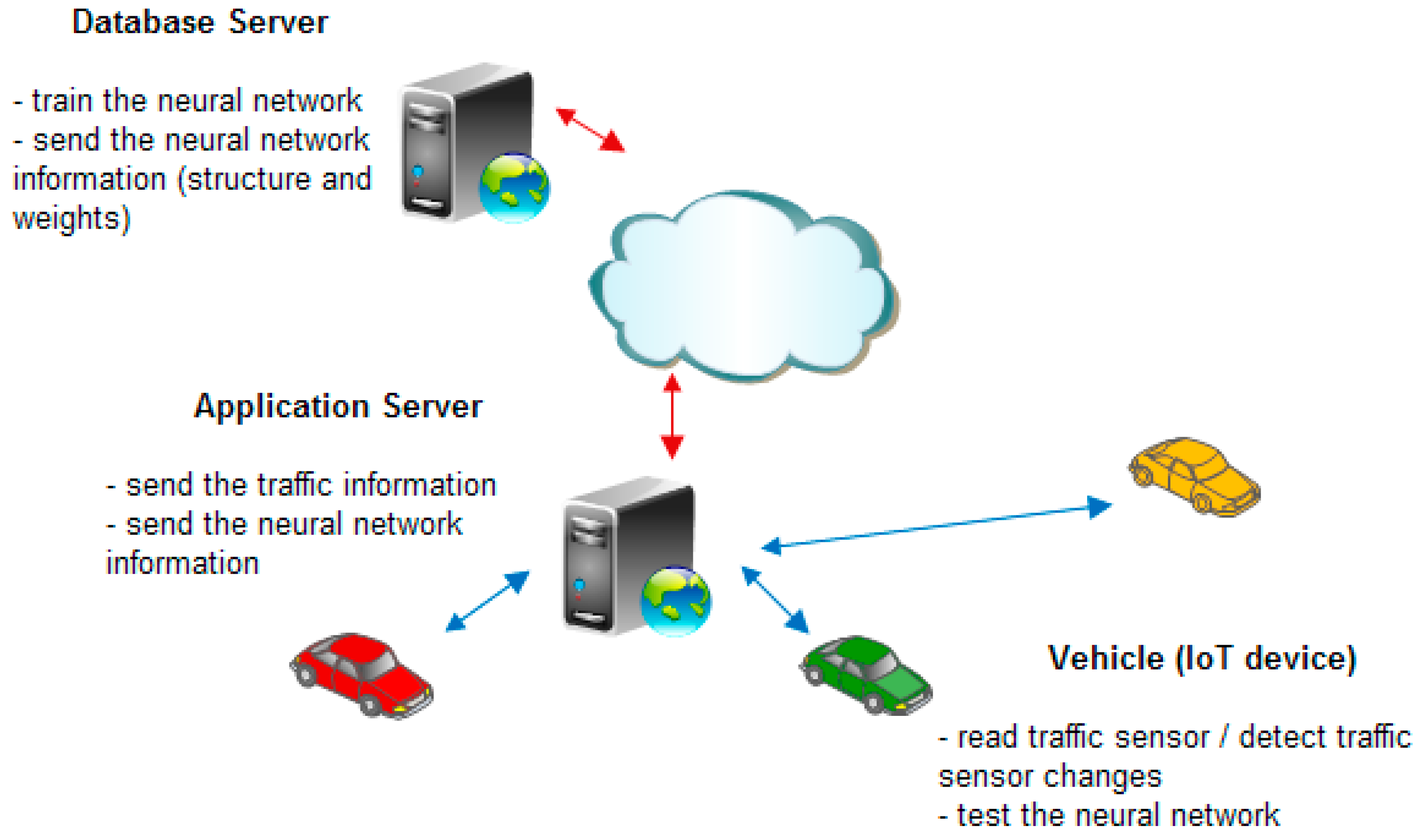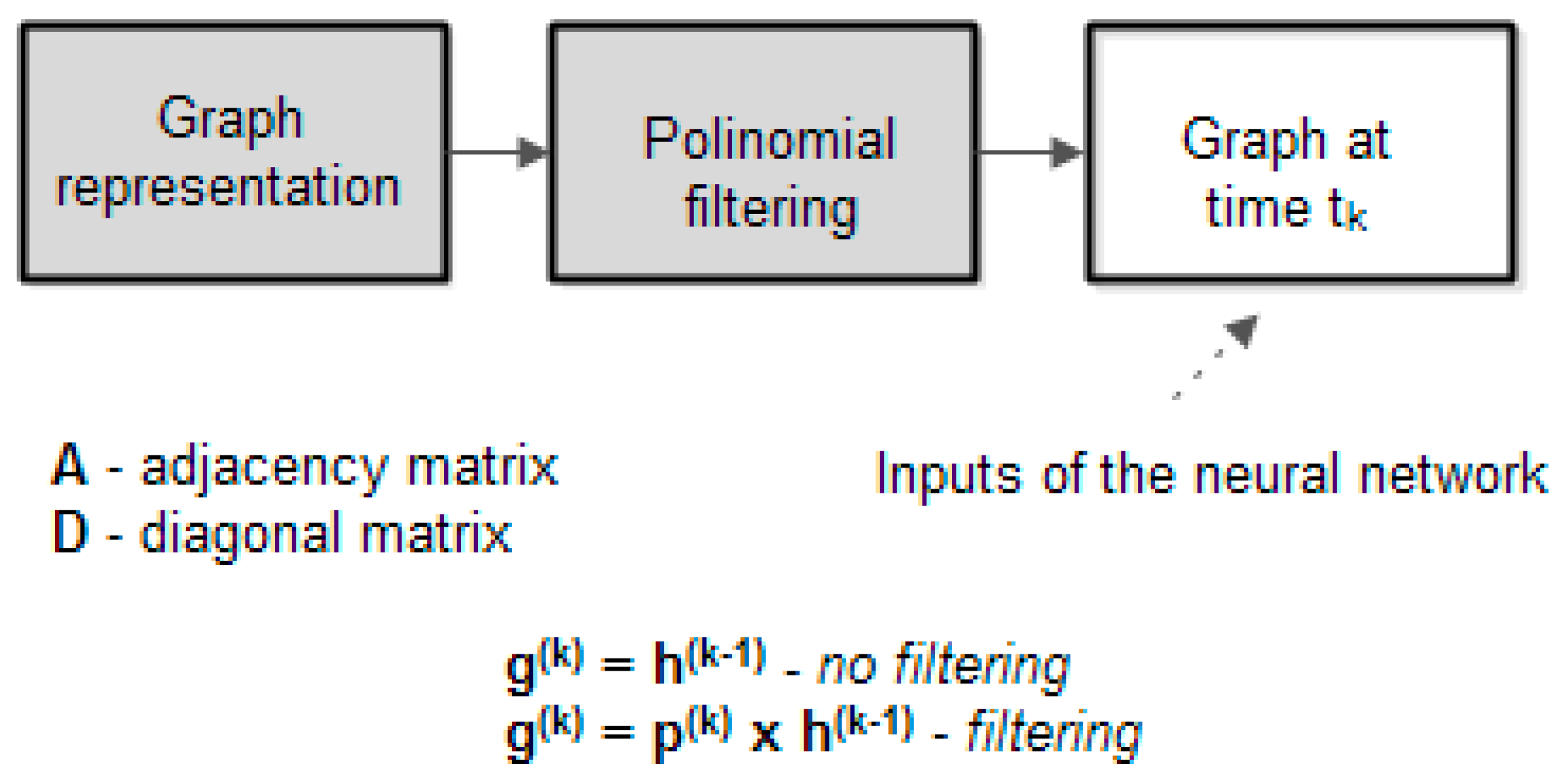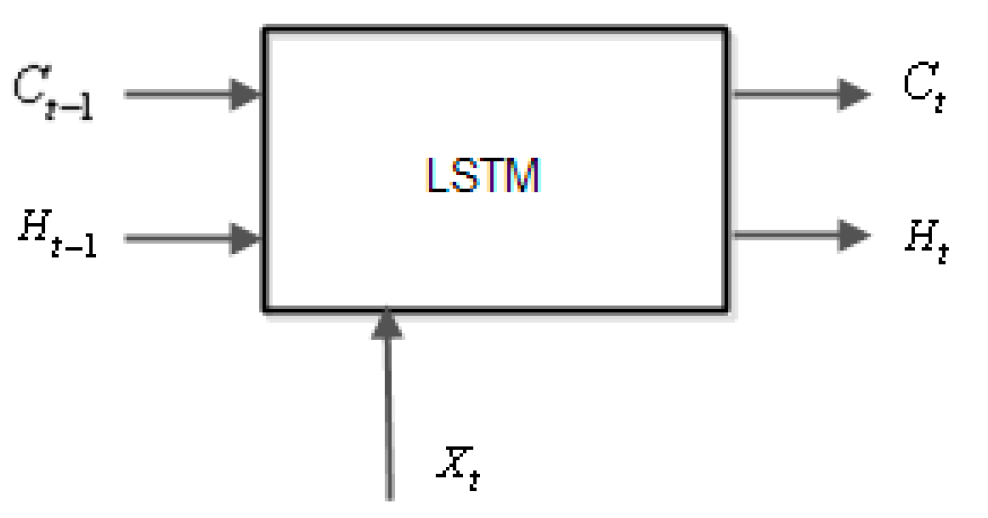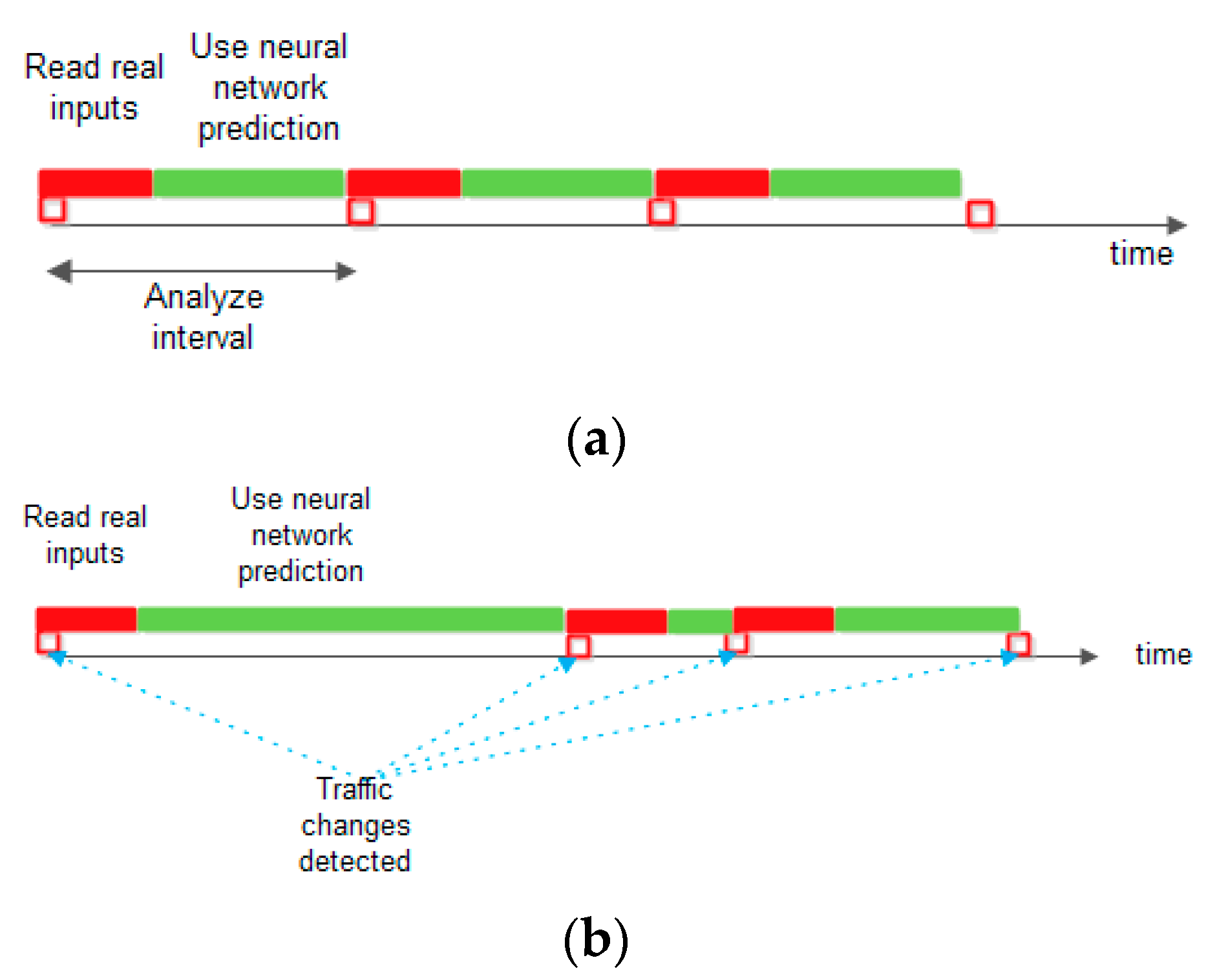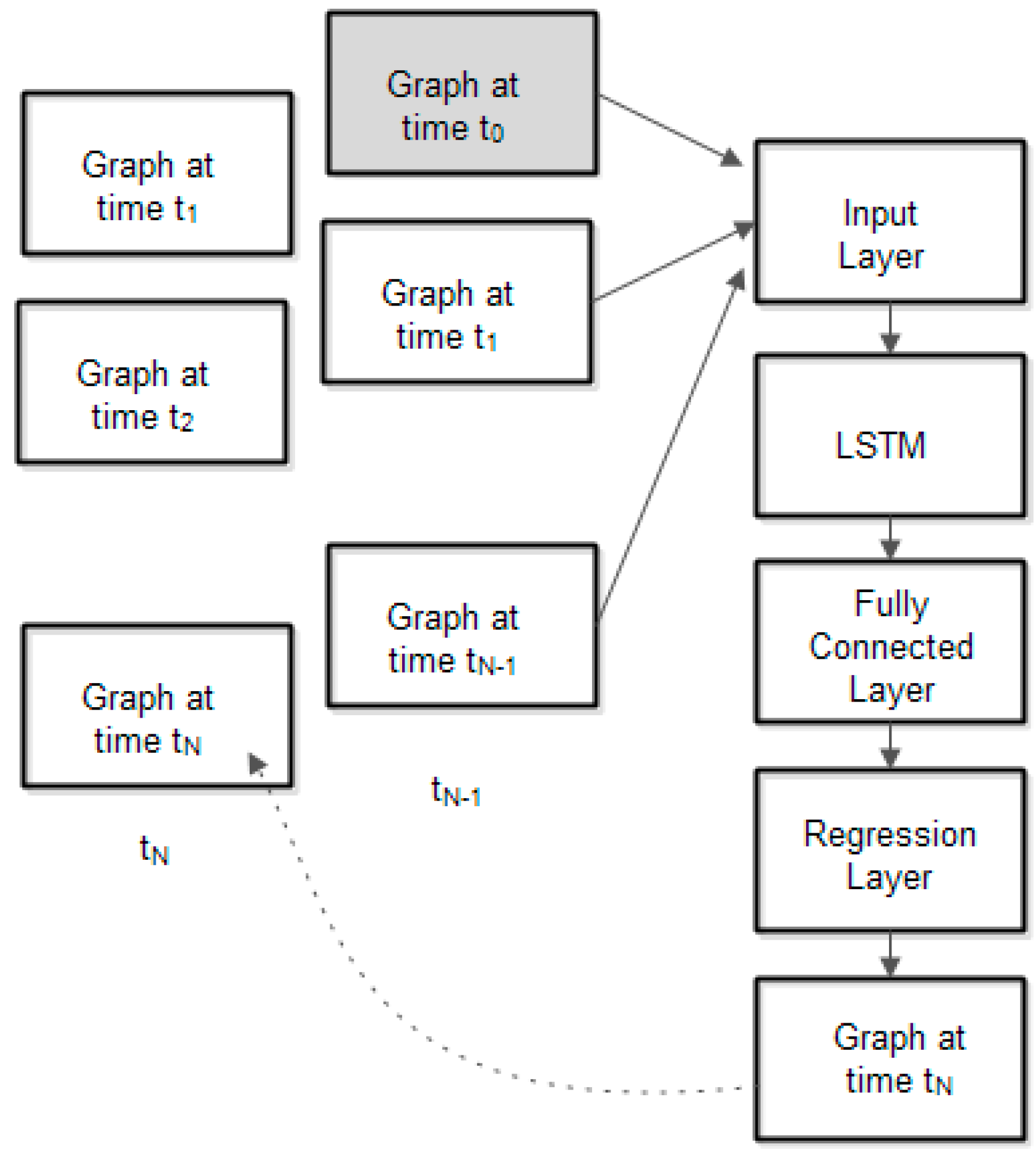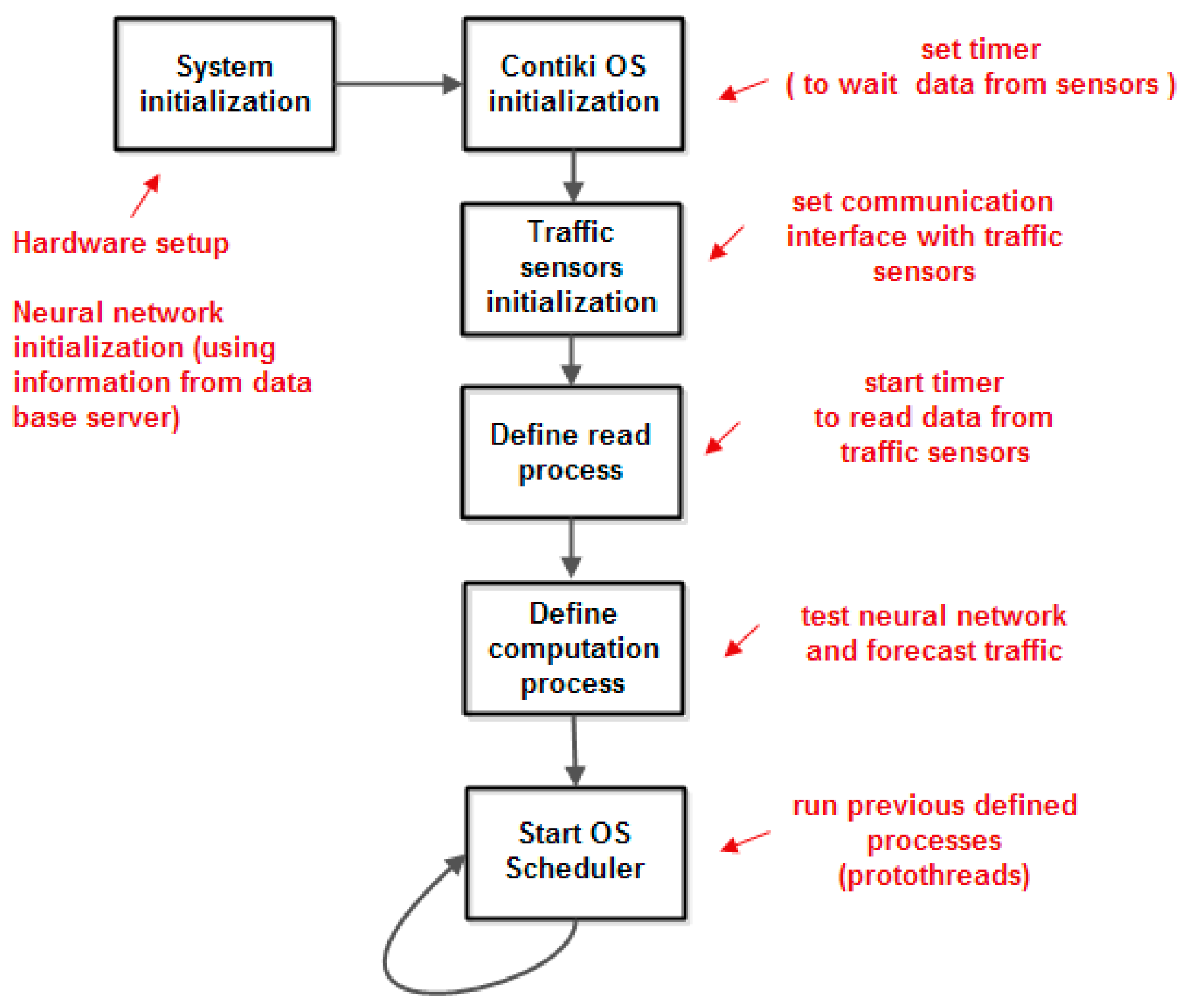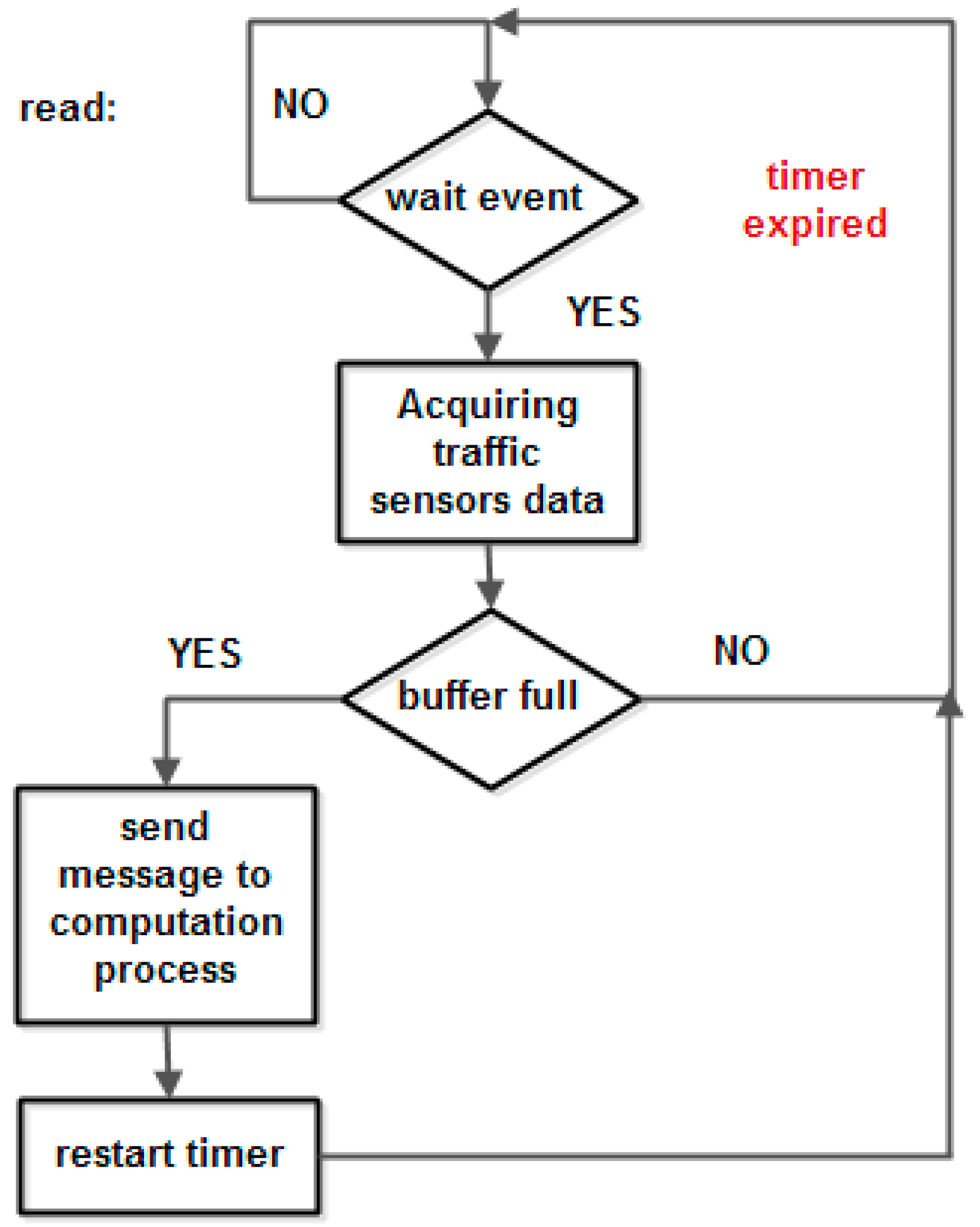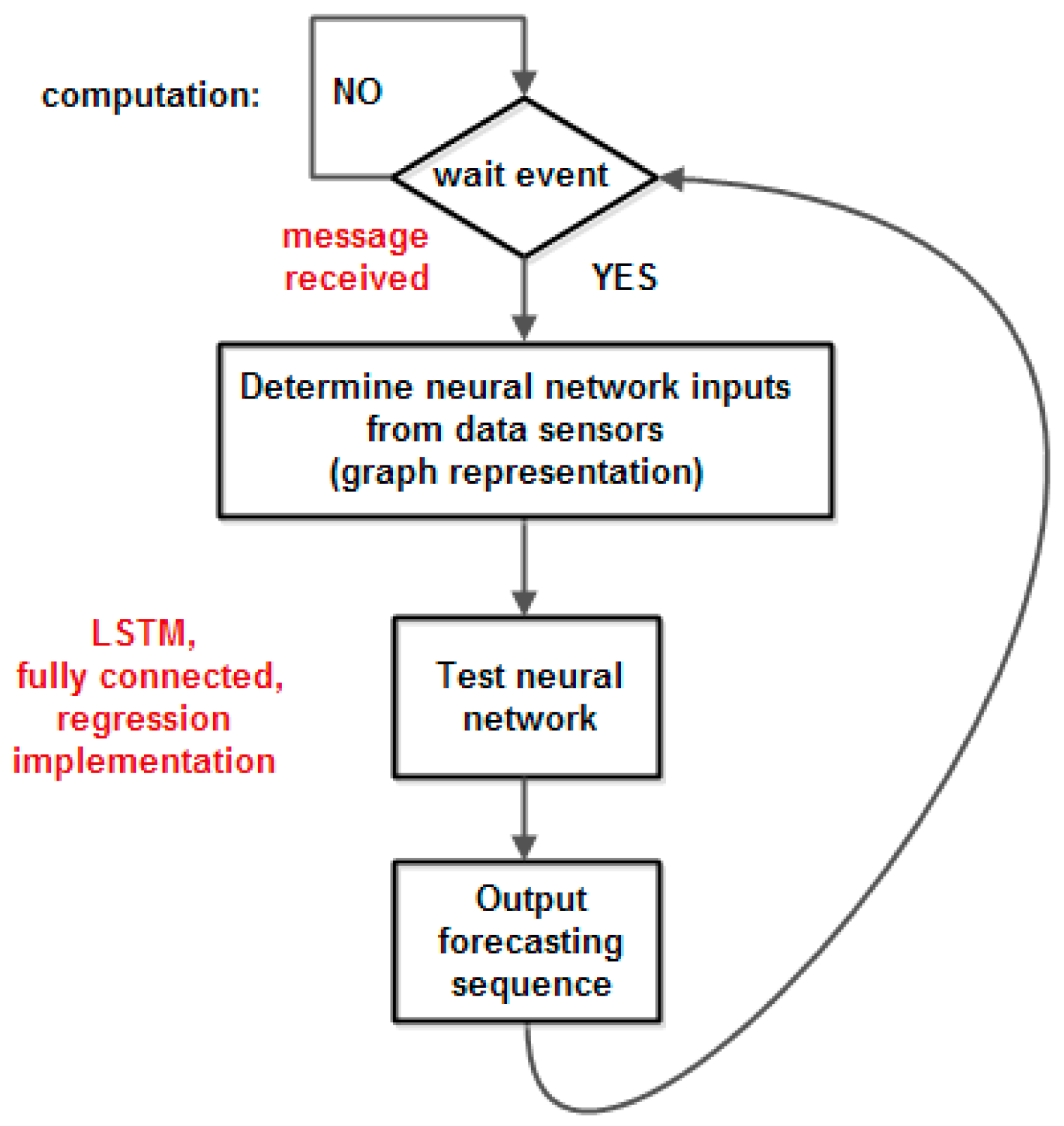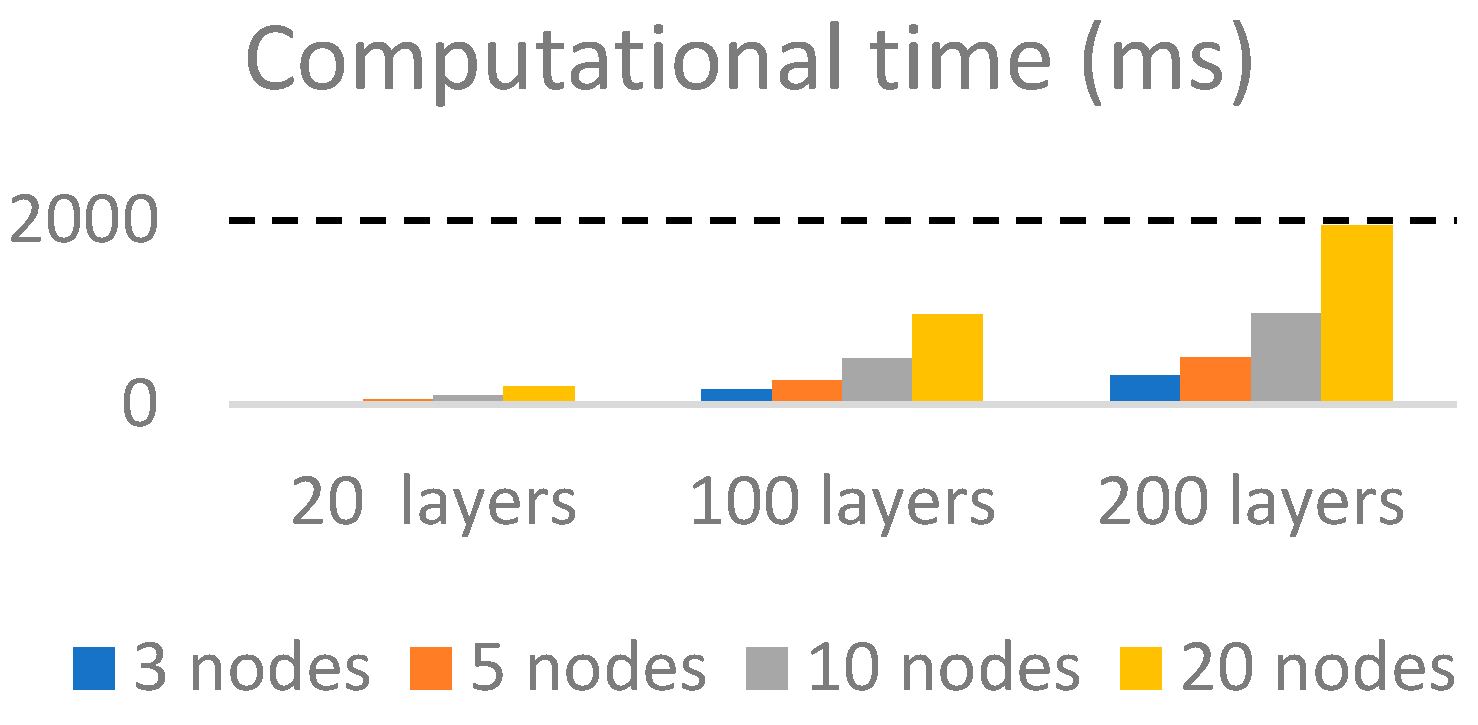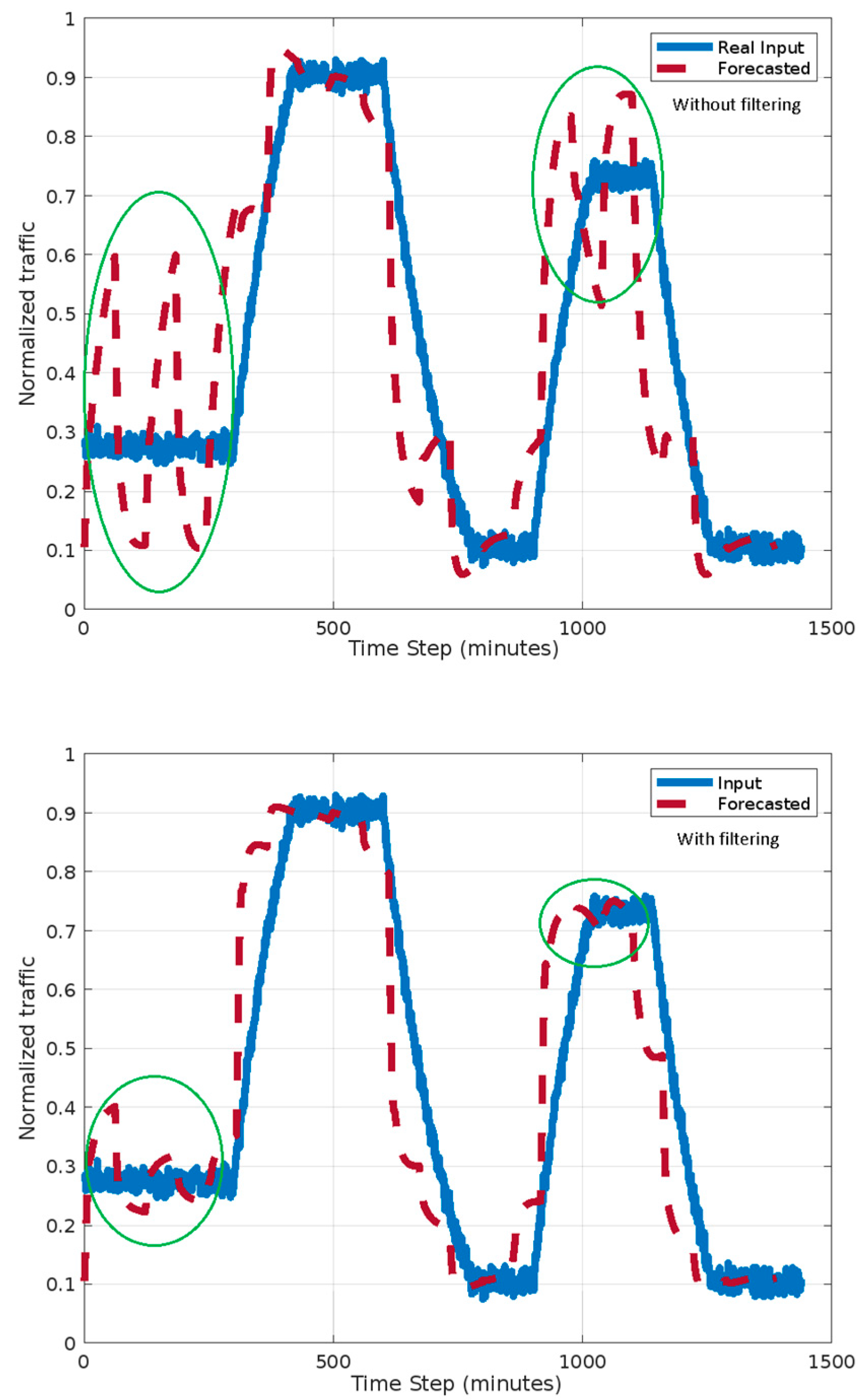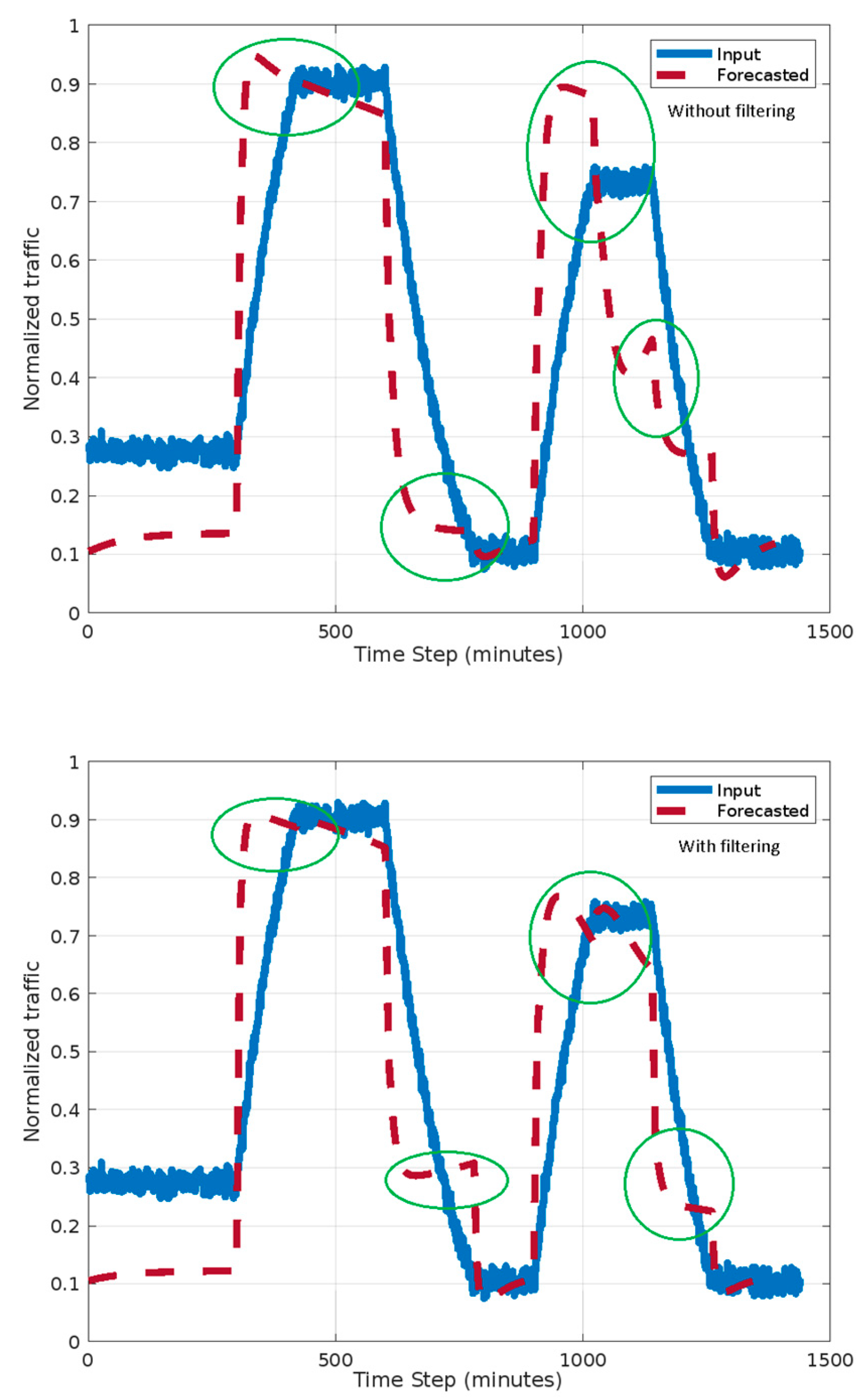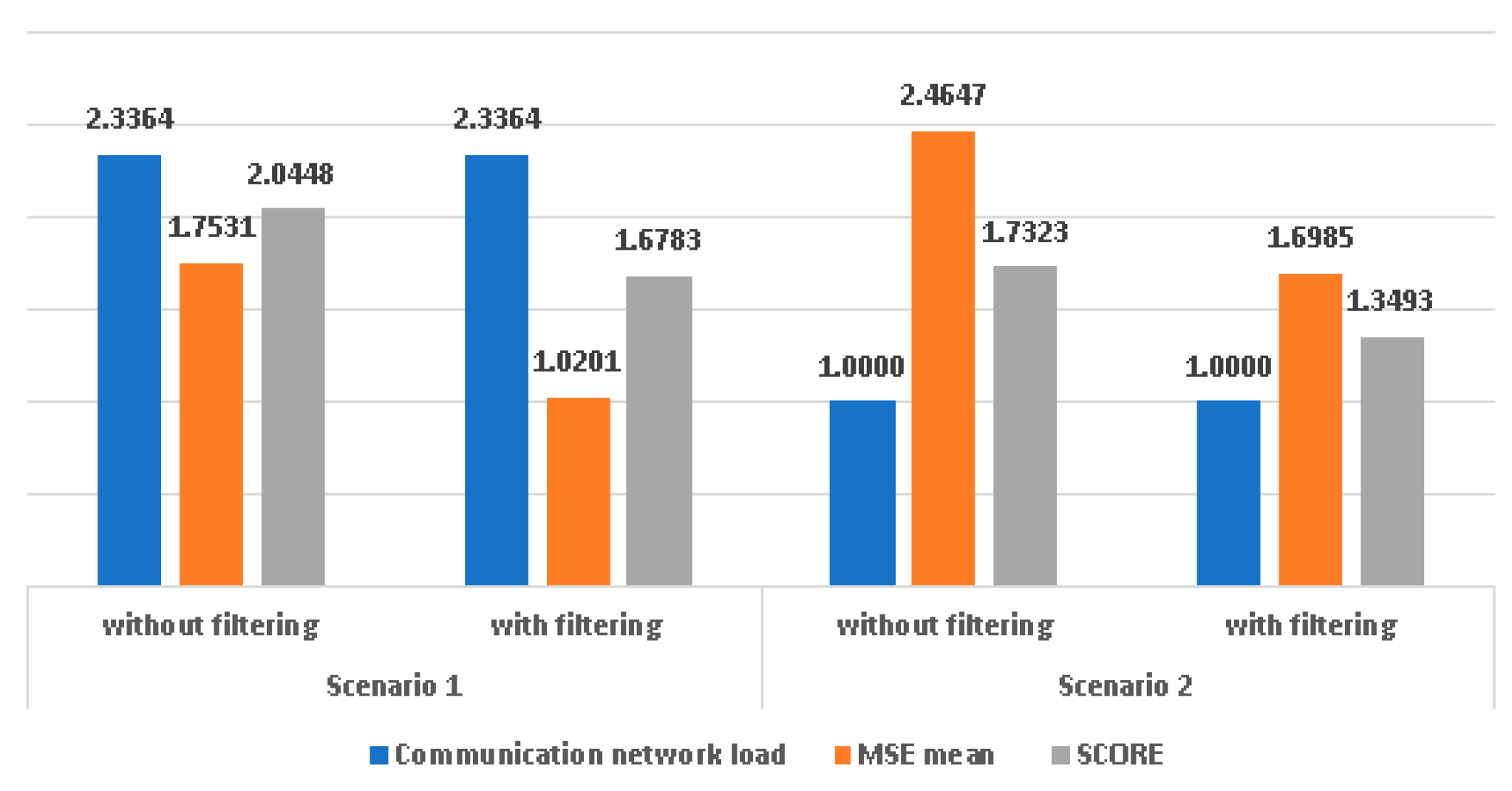1. Introduction and Related Work
Currently, neural networks can be implemented on embedded systems for speech recognition, object detection, human activity recognition, time series forecasting, etc.
Traffic prediction is currently important due to the large number of vehicles that transit road networks. Increased accuracy in predicting traffic will lead to the most efficient use of transport networks and help make decisions to increase the transport capacity on very congested routes. Also, traffic prediction shortens the transport times between two points by choosing a less-congested route.
Terrestrial transport networks are modeled as graphs with destinations (cities) as nodes (vertices). Each node can have several edges representing the paths between cities. The nodes contain information about the number of vehicles transiting the coverage area of the sensor associated with that node [
1].
Transport networks can be dynamic and have complex dependencies. This means that spatial–temporal aspects must be considered. For a graph representation, each node changes its traffic values over time. Traffic forecasting can be accomplished using a neural network that considers both spatial characteristics (the way the nodes are connected) and temporal characteristics (the modification of the traffic values in the node over time). The inputs to the neural network are represented by graphs at different time points. The output of the neural network is a graph that has predicted information (the number of vehicles and their speed) in nodes and edges.
One of the impactful applications of graph-based neural networks (GNN) is in improving the accuracy of estimated arrival time by learning the structure and dynamics of a transport network through the neural network. Using such neural networks, future traffic prediction algorithms can be created (used, for example, by Google Maps) [
2].
Using GNN is a challenge due to spatial–temporal complexity, but there are advantages in relation to other classical neural networks (for example, convolutional neural networks that cannot represent the topological structure of a transport network).
For traffic prediction, a graph built according to the topology of a transport network is naturally used. The main problems that can be seen on this graph include the number and type of vehicles on the road, their speed, road events, etc. [
3].
Another important problem studied in connection with the use of graphs in neural networks refers to how they are represented. Basic methods of graph representation (the adjacency matrix, neighbor matrix, distance matrix, and Laplacian matrix) are shown in [
3]. There are graph transformation methods for better scalability, such as GraphGPS, as described in [
4], and TokenGT, as detailed in [
5].
Code examples in high-level programming languages that implement a neural network based on graphs are illustrated in [
3].
The use of microcontrollers for the implementation of neural networks (testing phase) must consider the memory requirement, processing accuracy, and execution time. The continuous development of microcontroller architectures makes such implementations viable, but further research is still needed, especially for neural networks with a higher degree of complexity [
6].
Data compression methods used to reduce memory requirements are illustrated in [
7]. Some classical neural network architectures (the recognition of human activity and image processing) have already been ported to microcontrollers [
7].
However, implementation problems in devices with limited resources (not powerful computing systems) are not addressed very much in the literature. In the present work, the possibility of realizing an implementation on microcontrollers is studied, and the performances are analyzed.
The main purpose of the article is to evaluate if neural network implementation (testing phase) is viable under the conditions of using limited resources (such as memory, calculation speed, and numerical precision) that a microcontroller has. From the literature, we can mention some papers that study the implementation of a neural network on microcontrollers such as the ARM microcontroller [
8,
9] and address the problem of finite precision of such microcontrollers [
10].
Neural networks based on graphs are successfully used in traffic prediction, traffic congestion, traffic surveillance, and even in the assisted driving of vehicles. Based on these networks, traffic signal control systems, traffic incident control systems, and optimal route prediction can be created.
The data sets used as inputs in neural network (the information from the graph nodes that model the transport network) can be taken from sensors placed on the road, from GPS systems, or from specific applications that monitor vehicles (for example, in public transport). The graphs can be represented either as directed graphs (the direction of travel of the vehicles is considered) or as non-oriented graphs (ignoring the direction of travel of the vehicles). The representation mode of the graph influences the performance of the neural network, but from the perspective of its real-time implementation, a simpler but effective representation mode must be chosen. Most works indicate a graph representation using the Laplacian matrix and a recurrent neural network (usually LSTM) [
11,
12].
The input data set can be coded in such a way as to include external factors (for example, weather conditions) [
13,
14]. However, increasing the complexity of the input data set will increase both the training time and the prediction time in the testing phase. In this paper, we considered a simplified set of input data, the traffic load, which is taken either from sensors (real traffic) or from the output of the neural network (predicted traffic).
Starting from these choices, this paper creates a framework for the real-time implementation of a neural network based on graphs and evaluates its performance in terms of prediction time and prediction accuracy under the conditions of using limited resources.
The following aspects are addressed in this paper:
What type of neural network should be chosen so that the implementation can be carried out on microcontrollers (with relatively limited resources);
What is the number of graphs at the input so that the prediction is as good as possible (the maximum number of time points);
How the graph can be represented to improve the neural network performance;
Evaluation of computing time and prediction accuracy.
The main issues encountered are low power consumption, numerical representation, memory requirements, and execution time.
On the other hand, the embedded system should be able to run all the necessary tasks required by the above-mentioned applications, i.e., acquire the data sensors, test the neural network, decide, and transmit it to a server for monitoring and to take further actions. There is no need for the neural network training to be run on the embedded node, since it can be run separately; the neural networks parameters are transmitted to embedded nodes.
This paper defines and analyses a framework for using neural networks to implement various embedded applications.
The system has two components: the developing phase and the operating phase. In the developing phase, the necessary sensor data (e.g., traffic information: number of vehicles that transit a specific node, their speeds) are collected by an application server that transmits this data to a database server which trains a neural network and returns the neural network parameters to the vehicles via an application server. In the operating phase, the neural network is tested, and a forecast is made as shown in
Figure 1.
The system in
Figure 1 is made up of a series of sensors, placed on the road, that take specific traffic information (number of cars and their average speed). Vehicles on the road can periodically read sensors or be informed of changes in sensor values. The vehicles can communicate with an application server that takes the same information from the sensors and transmits it to a database server that periodically trains a neural network with a specified architecture and determines its learnable parameters. The type of neural network and these parameters are transmitted back to the application server which transmits them to the vehicles.
According to the chosen scenario, the vehicles can read the sensors and run a program that tests the neural network, with the parameters taken from the application server, to predict the traffic and choose an optimal route. The prediction is more accurate if the vehicles use the values from the sensors as input to the neural network, but the load on the communication network is higher. On the other hand, reading the sensors less often reduces the load on the communication network, but the neural network uses the predicted values as inputs and, therefore, the accuracy of the prediction is lower, because the predicted values can be different from the real traffic values. A compromise must be made between the load of the communication network connecting the vehicles, the application server, and the database server and the accuracy of the prediction.
In this work, we consider scenarios in which the vehicles transiting roads request information about the traffic load and can predict the traffic to choose a route as short as possible to decrease road congestion, the travel time, and amount of energy consumed [
1,
16].
This paper presents cases derived from the point of view of the reading mode of sensors according to the models found in real-time systems: time-triggered and event-triggered. These scenarios evaluate the load of the communication network connecting the system components (especially vehicles and sensors) to obtain a compromise between a reduced load of the communication network and the accuracy of the prediction.
Spatial–temporal interactions are captured by using graphs as reinforcements in a recurrent neural network. The training phase (implemented on the database server), with various inputs, which correspond to complex transport networks and in which various traffic information is taken, optimizes the parameters of the neural network that are used in the normal operation of the system (testing phase) implemented on the vehicle microcontroller.
On the database server, one can train several types of neural networks with different architectures and/or numbers of levels and with different hyperparameters. In this way, the space–time problem associated with a neural network based on graphs and used for traffic prediction can be comprehensively captured.
However, this article is more focused on evaluating the possibility of real-time implementation of the test phase on vehicles.
The information is taken at specific moments in time from an application server which periodically updates its information from a database server.
The duration of the readings from the application server must be as short as possible to reduce the network load and to allow many vehicles to transit the same roads.
Two scenarios are analyzed: one in which the traffic prediction is performed using a constant analysis duration in which the real information from the nodes is read for a short period, after which the traffic prediction is made using the results provided by the neural network. In the second scenario, the traffic changes in the nodes are detected and the real information from the nodes is read for a fixed duration and then the traffic prediction is made from the neural network information until the next detection of a change in the real traffic.
For system implementation, one can choose a solution consisting of a powerful system on a chip from Analog Devices (consisting of ADuCRF101 which integrates an ARM Cortex M3 MCU at 16 MHz clock and a RF transceiver ADF7024) as hardware and AD6LoWPAN (which is the 6LoWPAN—IPv6 over Low-Power Wireless Personal Area Networks, provided by Analog Devices) with IoT operating system Contiki version 4.8 as software.
To make a prediction, a Long Short-Term Memory (LSTM) neural network is involved. This type of recurrent neural network has been proven to have good results in sequence prediction and their parameters were validated by simulation in MATLAB.
All the necessary functions that implement the neural network are considered and evaluated to see if the entire system can perform in real time using a microcontroller.
Considering a wireless node network in which a very important goal is energy conservation, specific implementation of threads (such as starting/stopping radio communication) should be implemented. In such cases, the event-driven model—described by a finite state machine (FSM)—is used. To simplify the system development, the threads can be replaced by protothreads that can be written without having to design finite state machines [
16].
Protothreads are a programming abstraction and they reduce the complexity of implementations of event-triggered systems by performing conditional blocking of event-triggered systems, without the overhead of full multi-threading systems. They are lightweight threads without their own stack. This is advantageous in memory-constrained systems, where a stack for a thread uses a large part of the available memory.
Protothreads are based on a low-level mechanism named local continuations that can be set (the CPUs are captured) or resumed. A protothread is a C function with a single associated local continuation. The protothread’s local continuation is set before a conditional blocking. If the condition is true, the protothread executes a return statement to the caller program. In the next instance, the protothread is running and the local continuation is resumed to the one that was previously set and causes the program to jump to the conditional blocking statement. The condition is re-evaluated and, if the condition is false, the protothread executes the function.
In this paper, we consider an IoT application that is implemented with Contiki operating system support. The Contiki OS is intended for networked, memory-constrained, and low-power wireless IoT devices. Contiki provides multitasking and has a built-in Internet Protocol Suite (TCP/IP stack) with low memory requirements.
The Contiki programming model is based on protothreads [
17,
18]. The operating system kernel invokes the protothread in response to an event (timers expired, messages posted from other processes, triggered sensors, incoming packets from a network neighbor node). In Contiki, the protothreads are cooperatively scheduled; therefore, the process must always explicitly yield control back to the kernel at regular intervals by using a special protothread to block waiting for events while yielding control to the kernel between each event occurrence. Contiki supports inter-process communication using messages passing through events.
2. The Graph Neural Network
To use a graph as input in a neural network, the information associated with graph (e.g., node values, edges cost) should be converted to an appropriate form to be used as neural network input.
Figure 2 illustrates how a graph can be represented with or without filtering. The greyed blocks transform the graph information, given as a vector (or matrix) that has on each line the data in a specific node. Each column represents specific information for a node. The way the graph is represented is presented below [
19].
Given a graph
G, it is characterized by its adjacency matrix
where
indicates the existence of edge between nodes
(1—presence, 0—absence) and
is the number of nodes. Also, a node in graph
G is characterized by the degree of the node which is the number of edges incident at the node. A diagonal matrix is defined as:
A difference matrix is involved to build a polynomial as follows: . The polynomial is a (n × n) matrix. We note the coefficients as vector .
The polynomial
is used as a filter to calculate the neural network inputs (features). The generic algorithm for the training phase of the graph neural network is illustrated below (the vector
represents the initial values in the nodes of the graph):
The vector represents the polynomial coefficients and represents the initial values in the graph’s nodes. The terms can be vectors if nodes have more information (e.g., numbers of vehicle stored by type or speed). The function is the activation function (e.g., sigmoid). The sigmoid function gives the best results in our experiments, compared with the RELU function, but the computational time is greater. If terms are vectors, the activation function is applied elementwise. The superscript index k represents the discrete time index. In the above algorithm, PREDICT indicates a regression layer that predicts the output from previous inputs and the target represents the expected output.
The novelty of this article is the implementation of a traffic prediction system based on a neural network that uses graphs. The method with Laplacian polynomials was chosen as the graph representation method—and it was proven through experiments that this leads to better system performance. The author’s contribution consists in choosing the coefficients of the Laplacian polynomial (to have a good predictor and a small calculation time).
This algorithm is a generalization of some graph neural network algorithms. Therefore, the above-presented algorithm represents a general framework that can be used to obtain specific implementations of known graph-based neural networks [
20]. For example, the equivalence with Graph Convolutional Networks (GCN) is proven below.
Consider a slight modification in the definition of adjacency matrix, as follows: . Then, the non-zero terms in the diagonal matrix are changed to .
If then and which represents the formulas for GCN.
3. The System Implementation
To forecast traffic, the Long Short-Term Memory (LSTM) neural network is an appropriate choice because the inputs are time series (the traffic values in each node in the graph that represents the transport road network and considers the spatial–temporal characteristics of the inputs).
The LSTM network [
19,
21] is a recurrent neural network that processes input data by looping over time steps and updating its state and contains information stored over all the previous time moments and consists of several cells as in the
Figure 3.
At a given moment of time t, the input cell is . The cell state at time t is , and the output is . The initial value of and at t = 0 is zero.
Assuming that
and
are
vectors,
are scalars, the weights
are
vectors, and the weight
is a scalar with
being the number of features (inputs in the neural network) and one output of the neural network, then the LSTM computations are the following relations:
At each time step, the neural network learns to predict the value of the next time step (the inputs are shifted by one time step) [
22]. The sequence output is determined by a neural network regression layer. There are two methods of forecasting: open-loop and closed-loop forecasting. Open-loop forecasting predicts the next time step in a sequence using only the input data (true input from traffic sensors). The output sequence is predicted using several past input sequences. Closed-loop forecasting predicts using the previous predictions as input and does not require the true inputs’ values to make the prediction. To make a prediction for current time, this method uses the predicted value (past the neural network output) as input. The open-loop forecasting method has the disadvantage of a greater network load because each vehicle on the road more often reads the traffic sensors, but the traffic forecasting is more accurate. On the other hand, closed-loop forecasting requires fewer readings of traffic sensors (and reduces the network load), but the forecasting is less accurate and depends on neural network accuracy and graph filtering.
The proposed method takes into consideration two factors: the communication network load (how often the inputs in the neural network are updated) and the neural network performance (in terms of forecast accuracy). The two proposed scenarios follow the methods used in the real world: time-triggered systems or event-triggered systems. While time-triggered systems (scenario 1) are suitable for more predictable traffic, the event-triggered system is used for bursting-like traffic. The two scenarios are somewhat complementary (they are applied in different situations). However, the time-triggered system is simpler to implement and covers the event-triggered system. The communication network load is greater in the time-triggered system (scenario 1) than in the event-triggered system (scenario 2), but the neural network performance is better if it reads real inputs more often (like in scenario 1) instead of using the predicted outputs (as in scenario 2). This paper evaluates the traffic forecasting system performance, taking into consideration the trade-off between the communication network load and prediction accuracy of the neural network, and focuses on evaluating the feasibility of real-time implementation using microcontrollers.
The data set is a matrix with N rows (where each row represents a graph node which models the transport layer) and M columns (as discrete time). The matrix element is traffic load (as a percentage relative to a maximum value of traffic) or may be a vector which contains traffic load, average speed of vehicles that transit the node, average number and type of vehicles that transit the node, etc.
In this paper, we chose to use only the traffic load to not impose high restrictions for a real-time implementation on the vehicles’ microcontroller. Depending on the response time imposed, a more complex implementation can be achieved.
The obtained results show that the response occurs within seconds for a data set containing traffic load information. Our estimation is that if the data set contains more information, the response time should increase to tens of seconds which may be acceptable in certain systems.
Of course, the computation time increases greatly in the training phase if the data set is more complex, but this phase is implemented in the database server and is outside the scope of this paper.
Figure 4 shows the two proposed scenarios.
Figure 5 presents the neural network architecture with the following layers: input layer, LSTM layer, fully interconnected layer, and regression layer.
Fully connected layer computation is: .
The neural network regression layer yields a predicted value by learning complex non-linear relationships.
The regression layer computes the half-mean-squared-error loss for regression tasks. For sequence-to-one regression networks, the loss function of the regression layer is the half-mean-squared-error of the predicted responses: . The output of the regression layer is the predicted sequence (that is, the predicted values in all nodes).
The data obtained from sensors can be traffic load (expressed as the ratio between the number of vehicles in the node and the maximum number of vehicles for all nodes), the average vehicle speed, the distance between nodes, etc. In our experiments, we consider the traffic load as node information. The neural network input is a matrix with N rows (number of nodes in graph) and M columns (discrete time). In future papers, we will extend the investigations, increasing the volume of node information.
The parameters of the neural network are determined by training it using an implementation in MATLAB (with traffic values like the real ones). Implementations were made for both scenarios and for both situations: without filtering or with filtering. The testing phase of the neural network (implemented on the vehicle’s microcontroller) uses parameters determined during the learning phase, which are optimized.
Future investigations will determine to what extent the optimization of neural network parameters (in the learning phase) can be implemented on microcontrollers, and how, in real time.
The training was performed using MATLAB and the parameters were experimentally chosen. A neural network with the following layers was used: sequence input with N dimensions (N numbers of nodes in the graph), LSTM with M hidden units, fully connected, and regression output (compute mean-squared-error). The testing phase was also implemented in MATLAB (only for validation) but it was implemented also using microcontrollers, following the procedure described in this article to evaluate the execution time and the accuracy. The main purpose of this article is to prove the feasibility of such an implementation (only for the testing phase).
The neural network training parameters are: 200 epochs with 7 observations each, 90% of observations used for training, and a learning rate of 0.001.
The neural network parameters have been optimized using the Regression Learner application in MATLAB. Training the neural network model in Regression Learner consists of two actions: train the neural network with a validation scheme and protect against overfitting by applying cross-validation and then train the neural network on full data, excluding test data. The application trains the model simultaneously with the validated model. To optimize the neural network’s learnable parameters, the cross-validation scheme is involved. The data set is partitioned into a few disjunct sets, and for each set, we train the neural network, evaluate model performance, and calculate the validation error over all sets. This method gives a good estimate of the predictive accuracy of the final learnable parameters trained. It requires multiple fits but efficiently uses all the data, so it can be used for small data sets. The Regression Learner exports the full optimized set of learnable parameters.
All the neural network’s learnable parameters are transferred from the database server to vehicles via the application server and they are used in the microcontrollers’ implementation for the testing phase.
5. The Main Results
We consider a transport network consisting of 5–20 nodes (cities) with several routes. Each node measures the inbound and outbound traffic. A vehicle on a road (an edge) should forecast the traffic to choose a route that is less busy to increase the transportation energy efficiency. The neural network was trained using MATLAB [
29] and it was tested using a C language implementation on microcontrollers on each vehicle [
15,
29]. The number of LSTM hidden layers is about 80 (our evaluation shows that increasing the number of layers does not improve the neural network performance).
The numbers of processor cycles of the function that implement LSTM relation are as follows: dot—857 cycles, sigmoid—164 cycles and tanh—59 cycles.
The execution time can be considered acceptable, as is shown in
Figure 9.
One can observe that the computational time is about 1 s for a neural network with about 100 layers. In
Figure 9, the filtering is not considered, but in case of filtering, the execution time is increased by less than 10%.
Considering a reasonable assumption that a decision can be made in maximum of 60 s, this framework can be used for a traffic forecasting system with about five features (that is, five adjacent nodes in each node) and an input buffer up to 600 observations.
The above two scenarios were evaluated in terms of forecasting accuracy.
The first and second scenario results are shown in
Figure 10 and
Figure 11. The traffic is normalized to a maximum estimated traffic level.
The circles in
Figure 7 and
Figure 8 indicate differences between the two scenarios both with and without filtering. One can observe that the forecast accuracy is better for the second scenario. The oscillations in forecasted traffic are eliminated if filtering is involved. This is due to a better choice of analysis interval.
To obtain a quantitative performance evaluation of the forecasting system, we compute the mean squared error as and take the mean MSE value as a metric to determine the forecast precision. We also consider the load of the communication network as a ratio of the reading time of the sensors and the analysis time.
For the first scenario, the analysis interval is 60 min and for each analysis interval, the real inputs are read in the first 10 min. In the second scenario, after each detected traffic sensors’ change, the inputs are read for 10 s. In our experiments, a real input change occurs, on average, at 140 s. The readings’ intervals are smaller in the second scenario (less than 5 min per hour); therefore, the communication network load is twice as small as that in the first scenario. The detecting of changes increases the computational time by about 5%. In both scenarios, one can observe better accuracy if filtering is involved.
The global evaluation of the performance is given by a score calculated as an arithmetic mean between the MSE and the load of the communication network normalized to the load of the second scenario.
Figure 12 indicates the overall performance of the forecasting system. In this figure, the communication network load was normalized to the load in the second scenario.
A lower score is better. One can observe that scenario 2 has better performance and filtering improves the performance in both scenarios.
Filtering improves accuracy in both scenarios.
Filtering leads to a greater improvement in the first scenario, which is simpler to implement. For the second scenario, which has a greater complexity, due to the necessity to detect significant changes in the input, filtering is useful, but the improvements are not so great as in the first scenario. Considering mean forecasting accuracy values, accuracy fluctuations, and communication network load with equal weights, the second scenario with filtering has better overall performance than the rest of the scenarios and the average overall improvement is about 27%. For both scenarios, an increase in reading time intervals leads to better accuracy, but the communication network load is increased. A trade-off between traffic forecasting accuracy and communication network load should consider determining the length of reading intervals.
